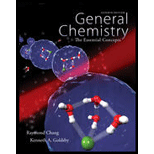
Concept explainers
(a)
Interpretation:
More stable isotope from the list has to be predicted.
Concept Introduction:
Nuclear stability means that the nucleus is stable meaning that it does not spontaneously emit any kind of radioactivity.
Nuclear stability can be explained based on neutron proton ratio (n/p) in the nucleus.
For a stable atoms having low
As the number of stable isotopes increases, stability of the element increases.
(b)
Interpretation:
More stable isotope from the list has to be predicted.
Concept Introduction:
Nuclear stability means that the nucleus is stable meaning that it does not spontaneously emit any kind of radioactivity.
Nuclear stability can be explained based on neutron proton ratio (n/p) in the nucleus.
For a stable atoms having low atomic number, n/p ratio is close to 1. When atomic number increases n/p becomes greater than 1.
As the number of stable isotopes increases, stability of the element increases.
(c)
Interpretation:
More stable isotope from the list has to be predicted.
Concept Introduction:
Nuclear stability means that the nucleus is stable meaning that it does not spontaneously emit any kind of radioactivity.
Nuclear stability can be explained based on neutron proton ratio (n/p) in the nucleus.
For a stable atoms having low atomic number, n/p ratio is close to 1. When atomic number increases n/p becomes greater than 1.
As the number of stable isotopes increases, stability of the element increases.
Want to see the full answer?
Check out a sample textbook solution
Chapter 21 Solutions
General Chemistry
 ChemistryChemistryISBN:9781305957404Author:Steven S. Zumdahl, Susan A. Zumdahl, Donald J. DeCostePublisher:Cengage Learning
ChemistryChemistryISBN:9781305957404Author:Steven S. Zumdahl, Susan A. Zumdahl, Donald J. DeCostePublisher:Cengage Learning ChemistryChemistryISBN:9781259911156Author:Raymond Chang Dr., Jason Overby ProfessorPublisher:McGraw-Hill Education
ChemistryChemistryISBN:9781259911156Author:Raymond Chang Dr., Jason Overby ProfessorPublisher:McGraw-Hill Education Principles of Instrumental AnalysisChemistryISBN:9781305577213Author:Douglas A. Skoog, F. James Holler, Stanley R. CrouchPublisher:Cengage Learning
Principles of Instrumental AnalysisChemistryISBN:9781305577213Author:Douglas A. Skoog, F. James Holler, Stanley R. CrouchPublisher:Cengage Learning Organic ChemistryChemistryISBN:9780078021558Author:Janice Gorzynski Smith Dr.Publisher:McGraw-Hill Education
Organic ChemistryChemistryISBN:9780078021558Author:Janice Gorzynski Smith Dr.Publisher:McGraw-Hill Education Chemistry: Principles and ReactionsChemistryISBN:9781305079373Author:William L. Masterton, Cecile N. HurleyPublisher:Cengage Learning
Chemistry: Principles and ReactionsChemistryISBN:9781305079373Author:William L. Masterton, Cecile N. HurleyPublisher:Cengage Learning Elementary Principles of Chemical Processes, Bind...ChemistryISBN:9781118431221Author:Richard M. Felder, Ronald W. Rousseau, Lisa G. BullardPublisher:WILEY
Elementary Principles of Chemical Processes, Bind...ChemistryISBN:9781118431221Author:Richard M. Felder, Ronald W. Rousseau, Lisa G. BullardPublisher:WILEY





